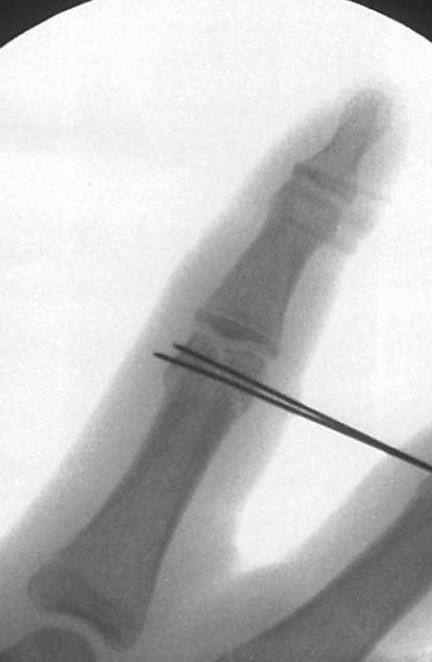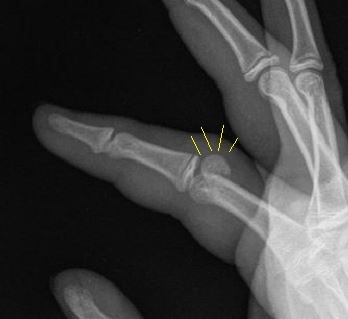Overview
Volleyball is a popular sport. It is usually played either indoors on a court or outdoors in the sand. Indoor volleyball has been an Olympic sport since 1964. Beach volleyball became an Olympic sport in 1996. Volleyball injuries are common and are often due to repeated jumping, hitting, and blocking.
Beach volleyball players have more shoulder injuries than court volleyball players. This is likely because there are only two players per team. Beach volleyball players have fewer ankle sprains and knee tendinitis due to the softer landing surface.
Common Injuries
Hitters and servers have a higher incidence of shoulder injuries. Setters and passers have a higher risk of wrist injuries. Blockers often injure their fingers (See figures 1 & 2).

Figure 2. Surgery allows healing in proper alignment

Figure 1. Index finger fracture with joint out of alignment. Hard hit ball struck finger during block.
Ankle sprains are the most common injury. These commonly come from landing on another player’s foot. Ankle sprains are treated first by RICE (rest, ice, compression, elevation). Some injuries will require X-rays. If the athlete can not bear weight on the injured foot/ankle, splints or casts may be very helpful. If the injury causes the joint to be out of alignment, surgery may be necessary. After recovering from the injury, exercises are done to strengthen the ankle and prevent further sprains or fractures. Ankle braces can be useful. Ankle and knee tendonitis are also common from frequent jumping. Treatment is focused on stretching and strengthening.
Anterior cruciate ligament (ACL): ACL tears are relatively rare but are very serious injuries. Females are at a higher risk of ACL tears than males. Players usually tear their ACL when landing awkwardly from a jump. The best treatment is prevention. There are many exercise training programs that focus on jumping and landing properly.
Wrist: Wrist inflammation can occur in setters and passers.
Spondylolysis: A stress fracture in the lower back that can occur with repetitive arching of the back. Hitters often arch their backs during spiking and can develop this problem.
Preparation
Warming up and stretching are very important. Cold muscles are stiff and more easily strained or torn. 20 minutes of easy warmup exercises and stretching helps the muscles get ready for activity.
Athletes can sweat around 1-2 liters (.5-1 gallons) every hour. Drinking fluids improves performance and prevents muscle fatigue and cramps. Thirst alone is a poor way of deciding how much fluid your body needs. Players should keep track of how much they sweat and replace it with water or sports drinks.
Heat stroke is a life-threatening emergency. This is caused by hot temperatures in combination with dehydration. This can cause confusion, headache, dizziness, or nausea and vomiting. Drinking lots of fluids and staying cool are key in preventing heat stroke. Sunscreen should be used if playing in sunny weather.
Proper equipment and technique are also important to prevent injuries. Footwork is important, especially around the net. Good jumping form can prevent tendinitis, ACL tears, and other serious injuries.
Prevention
Overtraining occurs when the body does not have enough time to rest and recover. This decreases performance and increases the risk of injuries. Change up the intensity of workouts to prevent overtraining. Be sure to include periods of rest or cross training to avoid overuse injuries.
Proper care of injuries helps to prevent them from turning into chronic problems. Playing through the pain or rushing back too early will most likely make the recovery time longer.
Many volleyball injuries in children can heal without surgery. However, if the symptoms are severe, or last longer than expected, talk to your physician.
Links
Page QR Code:


 POSNA.org
POSNA.org


